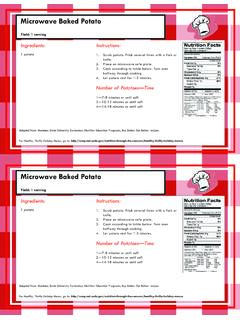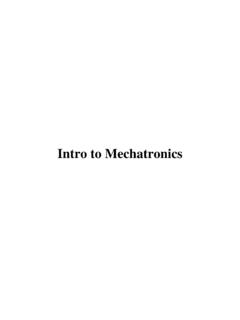Transcription of The Basics of Patch Antennas, Updated - Orban Microwave
1 As seen in the September 29, 2009 edition of the RF Globalnet ( ) newsletter. The Basics of Patch Antennas, Updated By D. Orban and Moernaut, Orban Microwave Products Introduction This article introduces the basic concepts of Patch antennas. We use a simple rectangular, half wave long, probe-fed Patch operating in its fundamental mode as an example. Topics include principles of operation, impedance matching, radiation patterns, circular polarization, bandwidth, efficiency, alternative feed types, stacked patches and higher mode behavior. This article was originally published in September 2005. After it was published, we received substantial feedback from those who read it.
2 The article has been revised based upon the feedback we received. Properties Of A Basic Microstrip Patch A microstrip or Patch antenna is a low-profile antenna that has a number of advantages over other antennas: it is lightweight, inexpensive, and electronics like LNA s and SSPA s can be integrated with these antennas quite easily. While the antenna can be a 3-D structure (wrapped around a cylinder, for example), it is usually flat and that is why Patch antennas are sometimes referred to as planar antennas. Figure 1 shows a Patch antenna in its basic form: a flat plate over a ground plane. This antenna is often built of printed circuit board material and the substrate makes up the Patch antenna s dielectric.
3 The distance between the Patch and the ground plane the substrate or dielectric height h determines the bandwidth. A thicker substrate increases the gain to some extent, but may lead to undesired effects like surface wave excitation: surface waves decrease efficiency and perturb the radiation pattern. Feature Article As seen in the September 29, 2009 edition of the RF Globalnet ( ) newsletter. The ground plane should extend beyond the edges of the Patch by at least 2 to 3 times the board thickness for proper operation. A ground plane that is too small will result in a reduced front to back ratio. Making the ground plane larger also increases the gain, but as the ground plane size increases, diffraction near the edges plays less of a role and increasing the size of an already large ground plane has very little effect on gain.
4 In the antenna in Figure 1, the center conductor of a coaxial line serves as the feed probe to couple electromagnetic energy in and/or out of the Patch . A thicker substrate leads to a longer feed probe, a larger feed probe inductance and a degradation of impedance matching. This can be compensated by using a different feed type and we ll look at alternative feed methods further down. electrical fieldprobe feedfeedlinefringe fieldfringe fieldtop layersubstrateground planezyx Figure 1: Cross section of a Patch antenna in its basic form A half wave long Patch operates in what we call the fundamental mode: the electric field is zero at the center of the Patch , maximum (positive) on one side, and minimum (negative) on the opposite side.
5 These minima and maxima continuously change side like the phase of the RF signal. The electric field does not stop abruptly near the Patch 's edges like it would in a cavity: the field extends beyond the outer periphery. These field extensions are known as fringing fields and cause the Patch to radiate. Some popular analytic modeling techniques for Patch antennas are based on this leaky-cavity concept and the fundamental mode of a rectangular Patch is often denoted using cavity theory like the TM10 mode. This TM notation often leads to confusion and here is an attempt to explain that: Figure 1 uses a Cartesian coordinate system, where the x and y axes are parallel with the ground-plane and the z-axis is perpendicular to it.
6 Feature Article As seen in the September 29, 2009 edition of the RF Globalnet ( ) newsletter. TM stands for a magnetic field distribution between Patch and ground that is transverse to the z-axis of the antenna shown in Figure 1. This transverse with respect to the z-axis is usually dropped because the magnetic fields in Patch antennas are always transverse to their z-axis. So, we can simplify things and only consider three field components instead of six (magnetic and electric fields in each x, y and z axis): the electric field in the z direction, and the magnetic field components in x and y directions. In general, modes are designated as TMnmp.
7 The p value is mostly omitted because the electric field variation is considered negligible in the z-axis since only a phase variation exists in the z axis. So, TMnm represents the field variations in the x and y directions. The field variation in the y direction (impedance width direction) is negligible and m is 0. The field has one minimum-to-maximum variation in the x direction (resonance length direction and a half wave long), n is 1 in this case and we say that this Patch operates in the TM10 mode. Dimensions The resonant length (the x axis in Figure 2) determines the resonant frequency and is about d/2 for a rectangular Patch excited in its fundamental mode where d is the wavelength in the PCB material.
8 The Patch is actually a bit larger electrically than its physical dimensions due to the fringing fields and the difference between electrical and physical size is mainly dependent on the PC board thickness and dielectric constant of the substrate. A good approximation for the resonant length is: L d = r 0. This formula includes a first order correction for the edge extension due to the fringing fields, with: L = resonant length d = wavelength in PC board 0 = wavelength in free space r = dielectric constant of the printed circuit board material Other parameters that have less influence on the resonant frequency include: Ground plane size Metal (copper) and dielectric thickness Patch (impedance) width Feature Article As seen in the September 29, 2009 edition of the RF Globalnet ( ) newsletter.
9 Impedance Matching The feed position of a Patch antenna excited in its fundamental mode is typically located in the center of the Patch width direction (y axis) and somewhere along the Patch resonant length direction (x axis). The exact position along the resonant length is determined by the electromagnetic field distribution in the Patch . Looking at the current (magnetic field) and voltage (electric field) variation along the Patch , the current has a maximum at the center and a minimum near the left and right edges, while the electric field is zero in the center and maximum near the left and minimum near the right edges. Keep in mind that the field distribution constantly changes in amplitude and sign.
10 Figures 2 and 3 below clarify this: Figure 2: Current distribution on the Patch surface VI|Z|typical=200 |Z|=0 Figure 3: Voltage (V), current (I) and impedance (|Z|) distribution along the Patch 's resonant length Feature Article As seen in the September 29, 2009 edition of the RF Globalnet ( ) newsletter. From the magnitude of the current and the voltage, we can determine that the impedance is minimum (theoretically zero ) in the center of the Patch and maximum (typically a couple hundred ) near the edges. This means that there are two points where the impedance is 50 somewhere along the resonant length (x) axis of the element and this is where you would typically connect to the antenna.








